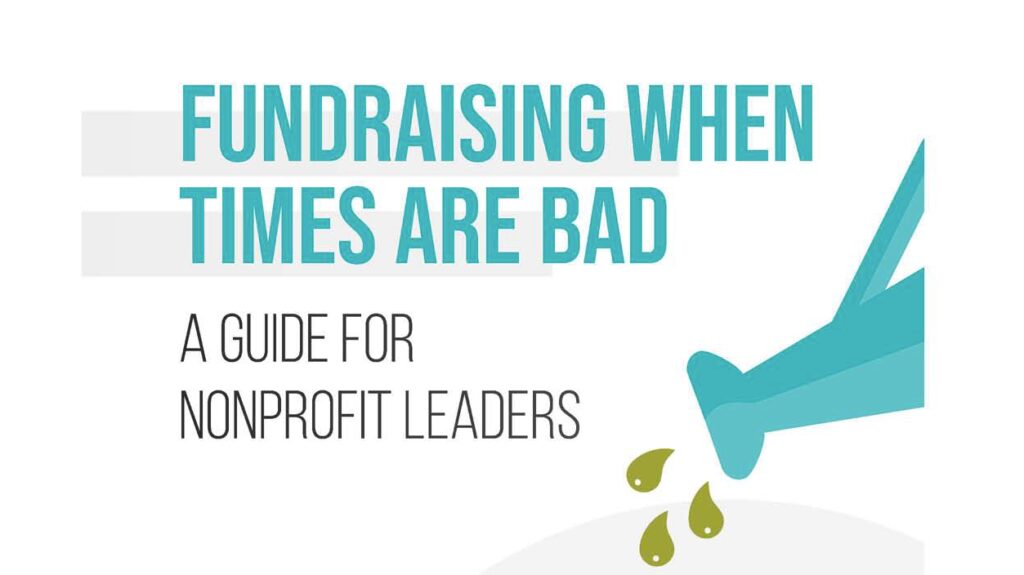If you, like most fundraisers, are facing difficult times in today’s economy, this e-book will help you think through strategy—and tactics—to navigate these stormy waters.
This is a sneak peek from Fundraising When Times Are Bad, a new e-book by American Philanthropic's founder and Philanthropy Daily's editor, Jeremy Beer. This book was written in response to the "Coronavirus economy" and draws upon the many Philanthropy Daily articles written to support fundraisers during difficult times. You can learn more and order a copy here.
Any crisis, no matter its nature, calls for a review of organizational strategy. In an economic recession or depression, the field of action changes decisively. That is even more true with respect to the coronavirus pandemic, which has dramatically transformed the way people interact with one another, and will probably continue to do so in some fashion for quite a while (although color us skeptical about the oft-heard claim that we will have to adjust ourselves to some radically different “new normal”).
A change in landscape means a change in strategy. You don’t need us or anyone else to give you the obvious advice that a review of your programs—both their content and their delivery—is in order. But what are some less obvious things for you to think about in terms of (1) your organization as a whole, and (2) fundraising, specifically?
THE SHORT TERM
When times are good and pocketbooks are bulging, it may not be all that difficult to achieve organizational growth. You may not need, or at any rate have, much of a plan. A flying-by-the-seat-of-your-pants strategy might work well enough, and besides there may be little time to sit down for some real strategic planning when there are big donors to see and exciting programs to execute.
But bad times . . . bad times are different. You need a plan, it needs to be truly strategic, and you need to lead by it. Having a strategic plan in place will help you prioritize resources and provide clarity for your decision making, pointing you toward not what just to do but also what not to do. If you want to not just survive but thrive, at least as compared to your nonprofit competitors, your plan should be a living one: nimble, flexible, reviewed often, and used as a compass by leadership and staff.
Let’s assume, first, that you already have a strategic plan in place. How should you go about making adjustments?
Typically, when you put together a strategic plan you start at the top with what you want to do (major goals, key objectives, numeric benchmarks). Then you drill down to the how (strategies, tasks, activities, and so on).
Our crisis advice? Turn this around. Start with the proximate, and work toward the higher-level goals and objectives from there. What tasks or activities were scheduled for the near term that you need to adjust or update? Are some of these things suddenly obsolete or simply impossible in light of COVID-19? How has the pandemic changed the landscape in which your organization operates? What can you still do right now? What can’t you do? Take a step back—stepping back seems always to be part of the planning process, doesn’t it?—and consider not only the challenges but also the new opportunities this situation presents you with. Some strategies, tasks, and activities may be difficult to carry out—big events, for example. But others may emerge as newly attractive and realistic—e.g., a virtual tour of your facilities for your major supporters.
Once you’ve reviewed the actions called for in your current plan, review your measurable objectives in light of the current situation as well, considering the original intent of the objective (such as reaching new audiences or serving current members) and how you might achieve a similar end goal through modified means. For example, if you wanted to reach “X” number of people through in-person events by “Y” date, might that be adjusted to reach “Z” number of people through some form of digital outreach by a revised deadline?
Changing one thing might not significantly affect other elements of the plan—but it very well may, and you need to take this probability into consideration. If you engage fewer donor prospects and by a later date, does that affect when and how you send a follow-up fundraising package? Do you anticipate less giving this year from your major donors, or a shift in the timing of these gifts, after reviewing your top donor list? How do these considerations affect your cash-flow projections?
These questions once again show the value of planning. Cash-flow changes are hard to predict and harder still to stomach. But it is better to have some idea of what you’re expecting (and why, based on your plan), as well as the tools to make informed adjustments.
A word here about the value of strategic plans: it may not be an open-and-shut case from a social-science perspective, but American Philanthropic’s survey data consistently shows that the largest—which is to say, on at least one metric the most successful— organizations are much more likely to have strategic organizational and fundraising plans in place than are smaller groups. They are also more likely to use those plans on a consistent basis. If you want to be like the big dogs, take time to plan and to lead by your plan.
THE LONG TERM
After you’ve adjusted your near-term plans, consider how this pandemic affects your organization on a larger scale. Take a look at your core strategies—those three or four things you are focusing on to move your nonprofit toward its overall goal—and determine whether they are still appropriate and workable given the current environment. The goalposts have shifted overnight. True, it is rare that changes in the economy or political climate will dictate changes to your core strategies—but then, these are rare times.
For example, if you do not have a robust communications strategy that includes digital outreach, social media, and online engagement tactics, you need one now. If you already have such a strategy in place, great: but maybe it needs to become a bigger focus. Were you dipping your toe in the digital marketplace? Perhaps it’s time to dive in instead.
Or maybe you have a core strategy based on growing your organization’s public presence through a series of in-person events. That can’t happen now and for the foreseeable future, so how can you pivot? Ask yourself what you were trying to achieve with that strategy—how was it advancing your mission?—and then think through the best way to replace it. The end doesn’t change; but the means may well.
Making major changes to your organization’s core strategies can be anxiety- provoking. But don’t let uncertainty translate into fear, never a good position from which to operate. You should not be reckless, of course, but you also don’t want to hunker down unnecessarily. If you have the necessary reserve funds or ongoing support from highly engaged supporters to make important strategic investments, then it is quite probable that you should still make those investments. Consider, too, whether you have the technology you need right now. If you had planned on improving your digital capacities, you might want to continue with that investment. It’s also a great time to be thinking about making database improvements.
If you can row upstream while others drift helplessly downstream, your comparative organizational strength will receive a real shot in the arm (we have reached that point in the book when we begin to recklessly mix metaphors).
Finally, remember your board—you know, that nominally governing body that probably, in normal times, either happily bumbles along following your direction or else, maddeningly, tends to insert itself in the wrong place at the wrong time. If there ever was a time for everyone to roll up their sleeves and contribute, it is now. The right place for board members to do this—excluding major gifts—is at the level of strategy. Perhaps this is an opportunity to get them engaged in a healthy way.
Still, don’t let uncommunicative or unhelpful board members slow you down. After all, if you are the CEO or executive director, you are the one charged with running the organization. It’s your career and your rear end on the line. No amount of governance theory can change that.
THE FUNDRAISING PIECE OF THE PUZZLE
During a recession, never cut the sales team. That’s a well-known mantra from the for-profit world, and it applies just as well to nonprofits. Fundraising is the last thing you should cut. Heck, you might even want to increase the resources you devote to fundraising.
Listen to what a couple of for-profit leaders have to say on this topic. Jerrod Stoller is the president of Digital Envoy, which provides IP-based geolocation and intelligence. “As a business leader,” says Jerrod, “our direct sales team members are the last ones off the ship” during an economic downturn. The reason is that by cutting your sales team, you are decreasing your ability to generate revenue—and hence making it that much harder to climb out of a financial hole. Plus, Jerrod points out, salespeople take longer to onboard, typically, than do other staff members; that’s certainly true of fundraisers, as every nonprofit CEO knows.
Instead, Jerrod says, the wise business leader seeks to batten down the hatches on operational expenses first. He looks hard at finance, accounting, HR, legal, and internal support functions. Then he looks to gain operational efficiencies in client servicing—in the nonprofit world, the analogous department here would be program. But whatever you do, try not to impact your ability to grow. That is the most important thing.
Josh Murphy serves as the president of the CrossFit Foundation, so he knows philanthropy, but he is also an executive sales leader in the life sciences industry. He emphasizes that even thinking about cutting your sales team when times are hard indicates a failure to understand how successful salespeople—and by extension, successful fundraisers—think about their jobs.
Good salespeople “live to serve their clients in a mutually beneficial way,” says Josh. “Why would you sever this critical relationship when times are tough and it is needed more than ever? An astute salesperson who can listen to their clients when the chips are down and there is no sale to be had will build lasting relationships that will bear fruit when things normalize.”
This dynamic is something nonprofit executives often fail to understand. They frequently think of sales, and fundraising, as icky. But Josh emphasizes that a good salesperson or fundraiser becomes a trusted advisor to their clients as his or her ultimate goal. And so, “if your sales team has this type of relationship with your clients, why would you sever this critical relationship during an economic downturn? Everything in your power should be done to maintain this relationship. In the for-profit world, I would say: Empower your sales team more than ever during these times. Encourage them to do what trusted advisors do best—listen and care about the challenges their clients are facing—and provide recommendations and solutions (even if they are not for your services or offerings) because that is how trust is built. It is your job to enable this trusted relationship to flourish.”
What Josh has to say about sales ought to be taken to heart by every nonprofit leader and fundraiser. The theme he comes back to again and again is the importance of listening.
“The discussion will invariably move from the macro-economic challenges that we are all facing to the specific and nuanced needs” that donors are facing, says Josh. “Just listen. They will be looking to do things differently than they have in the past, they will need new solutions to problems that they did not anticipate. What is driving their fears? Resist the urge to go into solution mode (unless they ask you specifically to). Try to just listen and be there for them.”
Now, back to the nonprofit world. During the Great Recession, Jeff Trimbath was on the development staff at the Heritage Foundation. A remarkable example of farsighted leadership that has always stuck with him is the story of how John Von Kannon, the legendary leader of the Heritage development department at that time (and a man whose “The Ten Laws of Fundraising” every nonprofit leader should read), instead of allowing the department’s budget to get cut, successfully persuaded Heritage higher-ups to increase the organization’s investment in fundraising. Everyone else is pulling back, Von Kannon argued.
Now is our chance to show center-right donors that we are the institution they can count on. Now is our chance to put introduce more of them to our work and to add them to our team.
The additional money Von Kannon won for his department didn’t go to salaries or bonuses, of course. It went straight to donor acquisition. And it worked. Boy, did it work. “That effort resulted in identifying hundreds of thousands of new donors in the years following the recession,” Trimbath remembers. Heritage’s leadership was so impressed that it earmarked additional funds for talent acquisition. “One of the fundraisers we hired in October 2009 went on to close the largest commitment in Heritage’s history just six years later,” says Trimbath. “Other nonprofits in our space spent their time explaining to their boards why they couldn’t raise money, and they responded by cutting mail programs and staff persons. Heritage sensed an opportunity, and it paid off.”
More than a decade later, and the Heritage Foundation is still the colossus bestriding the conservative scene in Washington, DC.
In short, the responsible thing to do during a downturn is not to cut fundraising—even though it may seem less essential to your mission—but to trim down on any unnecessary spending: staff lunches, upgraded airline seats, new laptops. If times get really tough, then begin to look at trimming program-related expenses. If you cut this luxury expense or that program feature while the country is in “crisis,” you do no long-term damage to your mission or organizational success. But if you cut fundraising while your competitors don’t, you risk serious long-term damage to your donor relationships and financial stability.
One of my wisest colleagues is Chris Kuetemeyer, who played a leading role in building the impressive fundraising operation that has made the Fellowship of Catholic University Students a dynamic and hugely popular organization. “Donors tend to continue supporting those to whom they are closest in times of crisis,” Kuetemeyer reminds us. “Now, therefore, is an important time to confirm your strong relationships with your donors. The best organizations and the best fundraisers are reaching out to their donors right now—and if you cut back on fundraising, your silence will stand out when you get in touch again.”
Perhaps you don’t quite believe Chris here. I know that in March and April 2020, when we pleaded with nonprofits to reach out to their donors, we sometimes encountered skepticism. “They don’t want to hear from us right now.” “I don’t want to bother them.”
Understandable sentiments. You want to reach out after a friend’s mother dies, for example, but not within thirty minutes of her passing.
Even so, these sentiments are often misleading. Your job as a fundraiser is to develop relationships with your donors in order to foster a sense of identity and belongingness between them and your organization—or rather, your mission. A crisis or market downturn will not ordinarily cause a donor to upend her own identity. If your donor thinks of herself as a deeply connected to your organization, then she will probably keep supporting you. But she may also need to hear from you in order to affirm and confirm that connection. If you don’t tell her that she is deeply valued as a friend, if you don’t call and listen, you are unintentionally signaling her unimportance to your enterprise.
WORK FROM A GIFT TABLE
We say much more about strategic planning, especially for fundraising, in The Forgotten Foundations of Fundraising, so we won’t go into the details here. One thing we don’t talk about there, though, but has become a staple of our planning process, is the gift table.
No one is a bigger believer in the power of a gift table than our friend Laurel McCombs, a senior philanthropy advisor at The Osborne Group. She is adamant that a gift table is, “bar none, the best way to plan how you will achieve your revenue goals and to make course corrections and adjustments throughout the year. It is a development professional’s best friend.”
Essentially, what a gift table does is to promote realism. A good gift table shows how many gifts are needed at various levels of giving in order for you to achieve a given revenue goal. For example, if your goal is to raise $1 million, then you can chart that goal on the table. One gift at $250,000, four at $100,000, five at $50,000, and ten at $10,000 will get you there.
As Laurel puts it, “A table of gifts orients your fundraising efforts by helping you to see exactly what asks you need to make and gifts you need to close in order to execute on your goals. You can see, in one place, the fundraising hill you have to climb and whether your goals are realistic. Often our programmatic eyes are bigger than our fundraising stomach, so to speak.”
Laurel is exactly right. As soon as you make your table, you will naturally begin to ask yourself: can we do this? In the example above, do you have any warm $250,000-level prospects? If two or three donors gave you that much last year, then obviously you do— unless the economic crisis has forced them into new circumstances. If, say, five or six donors gave you $100,000 last year, then you are probably still being realistic in hoping for $250,000 from one of them. But if your highest gift last year was $100,000 from one donor, and you know they can’t be moved beyond that, and your next highest gift was $50,000, followed by one at $25,000, and so on—well, you better have some other information that leads you to believe that you can find $250,000 from someone, because that kind of money doesn’t show up in the couch cushions.
Every organization, and every sector, even every giving level is different. But broadly speaking, we recommend that organizations have four to eight solid prospects for every gift they project in the gift table. You will likely need to meet with at least half those prospects in order to reach your goal.
Beside each level of your gift table, you should be able to write down the names of your top prospects in that category (at least, you should be able to the higher levels of the table, whatever that might mean for your particular organization).
Having enough prospects, and knowing who they are, is one thing. Having a plan for them is another.
“All donors need a plan—period,” says Laurel. “The question is not whether donors have donor plans, but how extensive their plans are. Lower-dollar donors don’t have individualized plans, but they do fit within various segments that map out how they will be engaged, solicited, and stewarded. Your major donors, however, should have individual plans—and your major donors are the ones at the top of your gifts table.”
Build your gift table for next year, fit your current donors in where you think they will be, according to your history and conversations with them, and see where that gets you. Soon enough, says Laurel, “you’ll know whether you can reasonably expect to meet your goals. Or, if it looks like you won’t meet them, you can have an informed judgment as to how short you will be.” What more can you ask for as a planner?
We never said it would be easy. Everything outlined here probably sounds like a lot of work. It is—but think of how much time, energy, and stress you will save by doing this work up front. And remember: any plan is better than no plan.
COMMUNICATE YOUR PLAN TO OTHERS
OK, you’ve revisited and adjusted your overall strategic plan and your fundraising plan. You forced realism on yourself by creating a gift table. Now it’s time to communicate whatever changes you have made, both internally and externally.
First, make sure staff are informed. It never ceases to amaze us how many groups keep their staff members in the dark—about finances, strategy, vision, major donors, and on and on. When we encounter that scenario, we know we are dealing with a controlling leader, a dysfunctional culture, or both. Don’t fall into one of those categories.
Not everyone needs to be involved in the process of updating the plan, of course, but everyone should know about final decisions. Provide an opportunity for questions and feedback—and if appropriate, make further adjustments based on that feedback.
Updating your strategic plan presents a splendid opportunity to communicate with your donors, too, especially your key financial partners. Let them know that you have revisited your organizational strategy and that you are stewarding your (or rather, their) resources as well as possible. They will appreciate knowing that they are investing in an organization with prudent leaders—especially now. You’ve already set yourself apart by having a truly operative strategic plan. Now you can further set yourself apart and impress your donors by quickly and intelligently updating your plan and sharing that process with them.
If you want to read more, you can order a copy here, or feel free to email austin@americanphilanthropic.com to learn more about the book.






